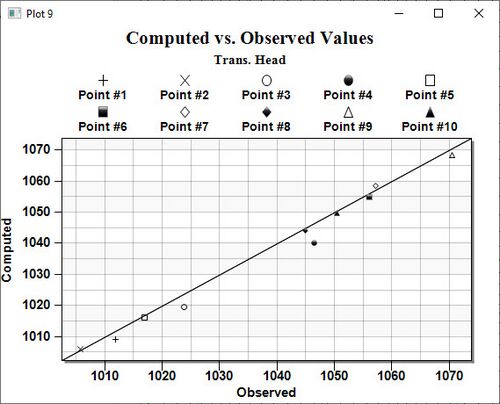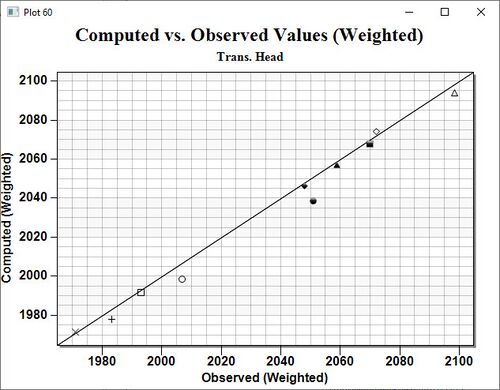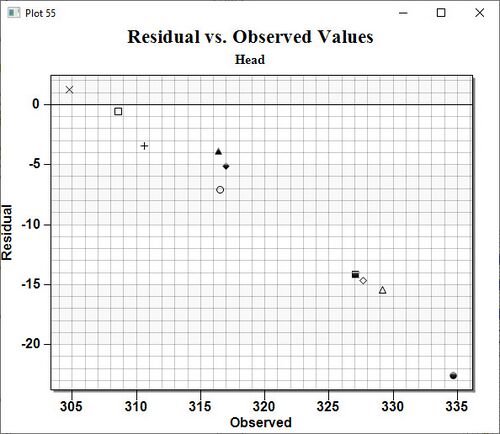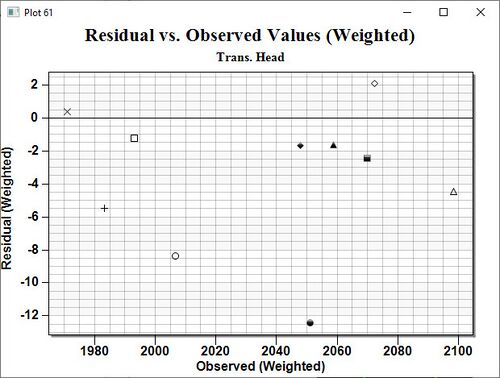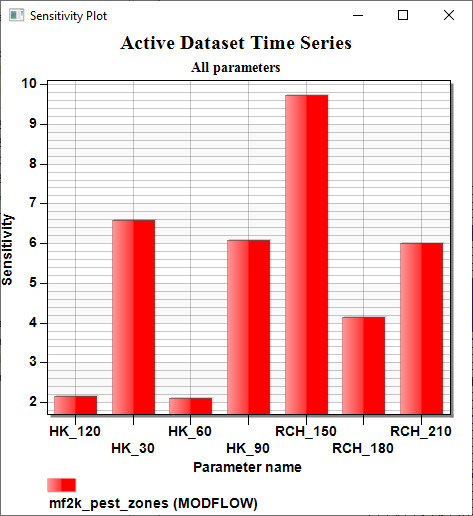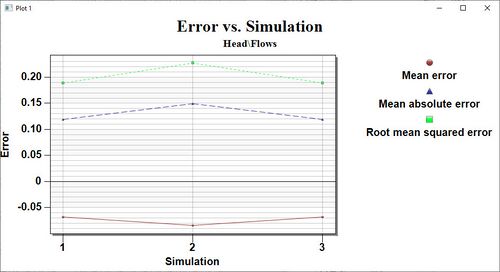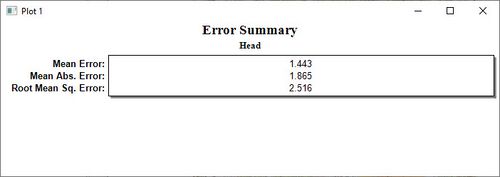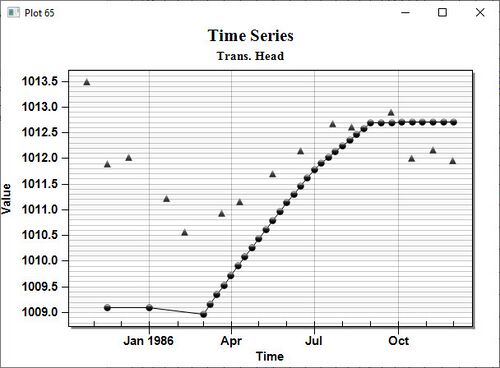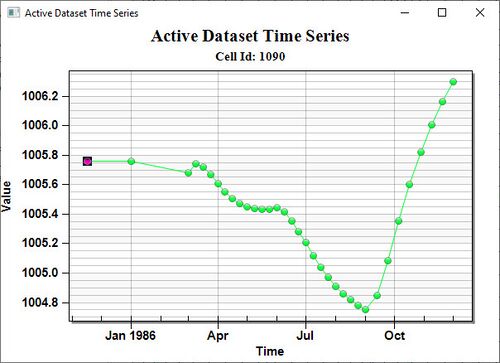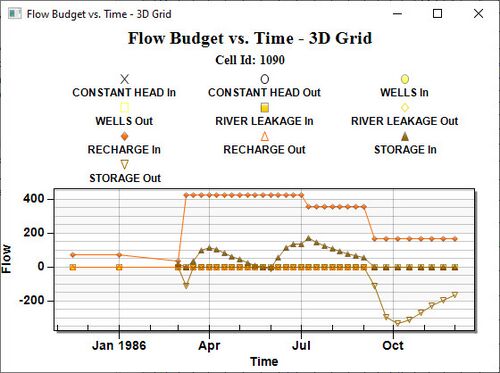GMS:Plot Wizard: Difference between revisions
From XMS Wiki
Jump to navigationJump to search
| Line 2: | Line 2: | ||
Plots are useful for many purposes, such as extracting data from two or three dimensional objects and model verification. Plots are created through the ''Plot Wizard''. | Plots are useful for many purposes, such as extracting data from two or three dimensional objects and model verification. Plots are created through the ''Plot Wizard''. | ||
The Plot Wizard (''Display'' | '''Plot Wizard''') is used to create 2D plots. The plot wizard is composed of two steps described below. In addition, the types of plots that can be created are described and illustrated below. | The Plot Wizard (''Display'' | '''Plot Wizard''') is used to create 2D plots. The plot wizard is composed of two steps described below. In addition, the types of plots that can be created are described and illustrated below. | ||
== | ==Plot Wizard Step 1== | ||
In the first step, the plot type is selected. The types include: | In the first step, the plot type is selected. The types include: | ||
| Line 25: | Line 24: | ||
A sample and explanation are displayed for each plot type. The '''Next >''' button is undimmed if the necessary data for the selected plot type exists in the current project. If the '''Next >''' button is disabled, a help text explaining the problem is displayed below the ''Plot Type'' box. | A sample and explanation are displayed for each plot type. The '''Next >''' button is undimmed if the necessary data for the selected plot type exists in the current project. If the '''Next >''' button is disabled, a help text explaining the problem is displayed below the ''Plot Type'' box. | ||
== | ==Plot Wizard Step 2== | ||
In the second step, the attributes of each plot are set. The attributes associated with each plot type are explained below and can be located quickly by clicking on the desired plot type listed above. The options depend on the plot type and will be described below. | In the second step, the attributes of each plot are set. The attributes associated with each plot type are explained below and can be located quickly by clicking on the desired plot type listed above. The options depend on the plot type and will be described below. | ||
=== Computed vs. Observed === | |||
A Computed vs. Observed plot is used to display how well the entire set of observed values match a model solution. A 45<sup>o</sup> line is drawn on this plot, which represents a perfect correspondence between observed data and solution values. One symbol is drawn for each observation point at the intersection of the observed and computed values for the point. This plot can show the trend of the solution values with regard to matching the [[GMS:Observations#Point Observations|observed data]]. Only those points whose value is specified as observed for the selected data type will be shown in the plot. These plots are created in the ''Plot Wizard'' by setting the ''Plot Type'' to "Computed vs. Observed". | A Computed vs. Observed plot is used to display how well the entire set of observed values match a model solution. A 45<sup>o</sup> line is drawn on this plot, which represents a perfect correspondence between observed data and solution values. One symbol is drawn for each observation point at the intersection of the observed and computed values for the point. This plot can show the trend of the solution values with regard to matching the [[GMS:Observations#Point Observations|observed data]]. Only those points whose value is specified as observed for the selected data type will be shown in the plot. These plots are created in the ''Plot Wizard'' by setting the ''Plot Type'' to "Computed vs. Observed". | ||
[[Image:comp_v_obs_plot.jpg|thumb|center|500px]] | [[Image:comp_v_obs_plot.jpg|thumb|center|500px]] | ||
==== Computed vs. Observed Plot Options ==== | |||
The second step contains the following options. | The second step contains the following options. | ||
: ''Coverage and Measurements'' | : ''Coverage and Measurements'' | ||
| Line 44: | Line 43: | ||
::Because the plot shows only values from a specific time step, The Active Times Step is used by default. | ::Because the plot shows only values from a specific time step, The Active Times Step is used by default. | ||
=== Computed vs. Observed (Weighted) === | |||
A Computed vs. Observed Weighted plot is used to display how well the entire set of weighted observed values match a model solution. These weights are set by selecting the [[GMS:Observations#Observations Dialog|'''Observation''']] item in the ''MODFLOW'' menu. A 45<sup>o</sup> line is drawn on this plot, which represents a perfect correspondence between observed data and solution values. One symbol is drawn for each observation point at the intersection of the weighted observed and computed values for the point. This plot can show the trend of the solution values with regard to matching the weighted observed data. Only those points whose value is specified as observed for the selected data type will be shown in the plot. This plot is not available with transient data. These plots are created in the ''Plot Wizard'' by setting the ''Plot Type'' to "Computed vs. Observed (Weighted)". | A Computed vs. Observed Weighted plot is used to display how well the entire set of weighted observed values match a model solution. These weights are set by selecting the [[GMS:Observations#Observations Dialog|'''Observation''']] item in the ''MODFLOW'' menu. A 45<sup>o</sup> line is drawn on this plot, which represents a perfect correspondence between observed data and solution values. One symbol is drawn for each observation point at the intersection of the weighted observed and computed values for the point. This plot can show the trend of the solution values with regard to matching the weighted observed data. Only those points whose value is specified as observed for the selected data type will be shown in the plot. This plot is not available with transient data. These plots are created in the ''Plot Wizard'' by setting the ''Plot Type'' to "Computed vs. Observed (Weighted)". | ||
[[Image:comp_v_obs_wt_plot.jpg|thumb|center|500px]] | [[Image:comp_v_obs_wt_plot.jpg|thumb|center|500px]] | ||
==== Computed vs. Observed Weighted Plot Options ==== | |||
After the plot type is set in the First Page of the ''Plot Wizard'', the '''Next''' button is clicked to open the ''Computed vs. Observed Weighted Plot Options'' wizard page. This page contains the following: | After the plot type is set in the First Page of the ''Plot Wizard'', the '''Next''' button is clicked to open the ''Computed vs. Observed Weighted Plot Options'' wizard page. This page contains the following: | ||
| Line 64: | Line 63: | ||
::Because the plot shows only values from a specific time step, The Active Times Step is used by default. | ::Because the plot shows only values from a specific time step, The Active Times Step is used by default. | ||
=== Residual vs. Observed === | |||
A Residual vs. Observed plot is used to display how well the entire set of observed values match a model solution. On this plot is drawn a horizontal line along an error of zero, representing what would be a perfect correspondence between observed data and solution values. Then, one symbol is drawn for each observation point at the intersection of the observed and residual (computed-observed) values for the point. This plot can show the trend of the solution values with regards to matching the [[GMS:Observations#Point Observations|observed data]]. Only those points whose value is specified as observed for the selected data type will be shown in the plot. These plots are created in the ''Plot Wizard'' by setting the ''Plot Type'' to "Residual vs. Observed". | A Residual vs. Observed plot is used to display how well the entire set of observed values match a model solution. On this plot is drawn a horizontal line along an error of zero, representing what would be a perfect correspondence between observed data and solution values. Then, one symbol is drawn for each observation point at the intersection of the observed and residual (computed-observed) values for the point. This plot can show the trend of the solution values with regards to matching the [[GMS:Observations#Point Observations|observed data]]. Only those points whose value is specified as observed for the selected data type will be shown in the plot. These plots are created in the ''Plot Wizard'' by setting the ''Plot Type'' to "Residual vs. Observed". | ||
[[Image:res_v_obs_plot.jpg|thumb|center|500px]] | [[Image:res_v_obs_plot.jpg|thumb|center|500px]] | ||
==== Residual vs. Observed Plot Options ==== | |||
After the plot type is set in the First Page of the Plot Wizard, the '''Next''' button is clicked to open the Residual vs. Observed Plot Options wizard page. This page contains the following: | After the plot type is set in the First Page of the Plot Wizard, the '''Next''' button is clicked to open the Residual vs. Observed Plot Options wizard page. This page contains the following: | ||
| Line 84: | Line 83: | ||
::Because the plot shows only values from a specific time step, The Active Times Step is used by default. | ::Because the plot shows only values from a specific time step, The Active Times Step is used by default. | ||
=== Residual vs. Observed (Weighted) === | |||
A Residual vs. Observed (Weighted) plot is used to display how well the entire set of weighted observed values match a model solution. On this plot is drawn a horizontal line along an error of zero, representing what would be a perfect correspondence between weighted observed data and solution values. One symbol is drawn for each observation point at the intersection of the weighted observed and residual (computed-observed) values for the point. This plot can show the trend of the solution values with regards to matching the [[GMS:Observations#Point Observations|weighted observed data]]. Only those points whose value is specified as observed for the selected data type will be shown in the plot. This plot is not available with transient data. These plots are created in the ''Plot Wizard'' by setting the ''Plot Type'' to "Residual vs. Observed (Weighted)". | A Residual vs. Observed (Weighted) plot is used to display how well the entire set of weighted observed values match a model solution. On this plot is drawn a horizontal line along an error of zero, representing what would be a perfect correspondence between weighted observed data and solution values. One symbol is drawn for each observation point at the intersection of the weighted observed and residual (computed-observed) values for the point. This plot can show the trend of the solution values with regards to matching the [[GMS:Observations#Point Observations|weighted observed data]]. Only those points whose value is specified as observed for the selected data type will be shown in the plot. This plot is not available with transient data. These plots are created in the ''Plot Wizard'' by setting the ''Plot Type'' to "Residual vs. Observed (Weighted)". | ||
[[Image:res_v_obs_wt_plot.jpg|thumb|center|500px]] | [[Image:res_v_obs_wt_plot.jpg|thumb|center|500px]] | ||
==== Residual vs. Observed Weighted Plot Options ==== | |||
After the plot type is set in the First Page of the ''Plot Wizard'', the '''Next''' button is clicked to open the ''Residual vs. Observed (Weighted) Plot Options'' wizard page. This page contains the following: | After the plot type is set in the First Page of the ''Plot Wizard'', the '''Next''' button is clicked to open the ''Residual vs. Observed (Weighted) Plot Options'' wizard page. This page contains the following: | ||
| Line 104: | Line 103: | ||
::Because the plot shows only values from a specific time step, The Active Times Step is used by default. | ::Because the plot shows only values from a specific time step, The Active Times Step is used by default. | ||
=== Parameter Sensitivity === | |||
A Parameter Sensitivity plot is used to display the sensitivity of the MODFLOW parameters. These plots are created in the ''Plot Wizard'' by setting the ''Plot Type'' to "Paramater Sensitivity". | A Parameter Sensitivity plot is used to display the sensitivity of the MODFLOW parameters. These plots are created in the ''Plot Wizard'' by setting the ''Plot Type'' to "Paramater Sensitivity". | ||
[[Image:par_sen_plot.jpg|thumb|center|500px]] | [[Image:par_sen_plot.jpg|thumb|center|500px]] | ||
===== Parameter Sensitivity Plot Options ===== | |||
After the plot type is set in the First Page of the ''Plot Wizard'', the '''Next''' button is clicked to open the ''Parameter Sensitivity Plot Options'' wizard page. This page contains the following: | After the plot type is set in the First Page of the ''Plot Wizard'', the '''Next''' button is clicked to open the ''Parameter Sensitivity Plot Options'' wizard page. This page contains the following: | ||
| Line 121: | Line 120: | ||
::This option causes the plot to compare Parameter Sensitivities of the specified solution. Changing the active solution does not affect the plot. | ::This option causes the plot to compare Parameter Sensitivities of the specified solution. Changing the active solution does not affect the plot. | ||
=== Error vs. Simulation === | |||
An Error vs. Simulation plot is generally used with steady-state simulations and measurement types. It may be used in transient simulations. This plot can display the mean error, mean absolute error, and root mean squared error between successive solutions and [[GMS:Observations#Point Observations|observed data]]. Various simulations would be run after changing model parameters, such as hydraulic conductivity or recharge. The plot will show trends in the solution to see if model parameter changes are causing better calibration with measured field data. Error vs. Simulation plots are created in the ''Plot Wizard'' by setting the ''Plot Type'' to "Error vs. Simulation". | An Error vs. Simulation plot is generally used with steady-state simulations and measurement types. It may be used in transient simulations. This plot can display the mean error, mean absolute error, and root mean squared error between successive solutions and [[GMS:Observations#Point Observations|observed data]]. Various simulations would be run after changing model parameters, such as hydraulic conductivity or recharge. The plot will show trends in the solution to see if model parameter changes are causing better calibration with measured field data. Error vs. Simulation plots are created in the ''Plot Wizard'' by setting the ''Plot Type'' to "Error vs. Simulation". | ||
[[Image:error_v_sim_plot.jpg|thumb|center|500px]] | [[Image:error_v_sim_plot.jpg|thumb|center|500px]] | ||
==== Error vs. Simulation Plot Options ==== | |||
After the plot type is set in the First Page of the ''Plot Wizard'', the '''Next''' button is clicked to open the ''Error vs. Simulation Plot Options ''wizard page. This page contains the following: | After the plot type is set in the First Page of the ''Plot Wizard'', the '''Next''' button is clicked to open the ''Error vs. Simulation Plot Options ''wizard page. This page contains the following: | ||
| Line 141: | Line 140: | ||
::There are three options that can be turned on or off. They determine whether the mean error, mean absolute error, and root mean squared error plots should be shown. Because these values are an average of all observation points, their line and symbol styles are not linked to any one observation point, but can be defined by clicking on the appropriate canvas window in the dialog. | ::There are three options that can be turned on or off. They determine whether the mean error, mean absolute error, and root mean squared error plots should be shown. Because these values are an average of all observation points, their line and symbol styles are not linked to any one observation point, but can be defined by clicking on the appropriate canvas window in the dialog. | ||
=== Error vs. Time Step === | |||
An Error vs. Time Step plot is used with transient simulations to display the mean error, mean absolute error, and root mean squared error between a solution and observed data as a function of time. This plot applies to a single dataset in a model solution. Transient measurement types will show the average errors at each time step of the dataset. Error vs. Time Step plots are created in the ''Plot Wizard'' by setting the ''Plot Type'' to "Error vs. Time Step". A sample plot is shown in the figure. | An Error vs. Time Step plot is used with transient simulations to display the mean error, mean absolute error, and root mean squared error between a solution and observed data as a function of time. This plot applies to a single dataset in a model solution. Transient measurement types will show the average errors at each time step of the dataset. Error vs. Time Step plots are created in the ''Plot Wizard'' by setting the ''Plot Type'' to "Error vs. Time Step". A sample plot is shown in the figure. | ||
| Line 148: | Line 147: | ||
[[Image:error_v_time_plot.gif|frame|center|300px]] | [[Image:error_v_time_plot.gif|frame|center|300px]] | ||
==== Error vs. Time Step Plot Options ==== | |||
After the plot type is set in the first page of the ''Plot Wizard'', the '''Next''' button is clicked to open the ''Error vs. Time Step Plot Options'' wizard page. This page contains the following: | After the plot type is set in the first page of the ''Plot Wizard'', the '''Next''' button is clicked to open the ''Error vs. Time Step Plot Options'' wizard page. This page contains the following: | ||
| Line 163: | Line 162: | ||
::There are three options that can be turned on or off. They determine whether the mean error, mean absolute error, and root mean squared error plots should be shown. Because these values are an average of all observation points, their line and symbol styles are not linked to any one observation point, but can be defined by clicking on the appropriate canvas window in the dialog. | ::There are three options that can be turned on or off. They determine whether the mean error, mean absolute error, and root mean squared error plots should be shown. Because these values are an average of all observation points, their line and symbol styles are not linked to any one observation point, but can be defined by clicking on the appropriate canvas window in the dialog. | ||
=== Error Summary === | |||
See the [[GMS:Error Summary Plot|Error Summary Plot]] page for more details. An Error Summary plot is used to display the mean error, mean absolute error, and root mean squared error for a Solution. Error Summary plots are created in the ''Plot Wizard'' by setting the ''Plot Type'' to "Error Summary". | See the [[GMS:Error Summary Plot|Error Summary Plot]] page for more details. An Error Summary plot is used to display the mean error, mean absolute error, and root mean squared error for a Solution. Error Summary plots are created in the ''Plot Wizard'' by setting the ''Plot Type'' to "Error Summary". | ||
| Line 169: | Line 168: | ||
[[File:Err summary plot.jpg|thumb|center|500 px]] | [[File:Err summary plot.jpg|thumb|center|500 px]] | ||
==== Error Summary Plot Options ==== | |||
After the plot type is set in the First Page of the Plot Wizard, the '''Next''' button is clicked to open the Error Summary Plot Options wizard page. This page contains the following: | After the plot type is set in the First Page of the Plot Wizard, the '''Next''' button is clicked to open the Error Summary Plot Options wizard page. This page contains the following: | ||
| Line 181: | Line 180: | ||
::This section shows the available list of observed values that were set up in the ''Observation Coverage Options'' dialog. Both constant and transient observed values should be available in this dialog. | ::This section shows the available list of observed values that were set up in the ''Observation Coverage Options'' dialog. Both constant and transient observed values should be available in this dialog. | ||
=== Time Series === | |||
A Time Series plot is used to display the time variation of one or more scalar Datasets associated to a given point inside a model solution. In addition, if transient calibration data has been defined, a band can be shown which represents a time variant [[GMS:Calibration Targets|Calibration Target]]. Only transient datasets may be used in these plots. Time Series plots are created in the ''Plot Wizard'' by setting the ''Plot Type'' to "Time Series". A sample plot is shown in the figure. | A Time Series plot is used to display the time variation of one or more scalar Datasets associated to a given point inside a model solution. In addition, if transient calibration data has been defined, a band can be shown which represents a time variant [[GMS:Calibration Targets|Calibration Target]]. Only transient datasets may be used in these plots. Time Series plots are created in the ''Plot Wizard'' by setting the ''Plot Type'' to "Time Series". A sample plot is shown in the figure. | ||
| Line 188: | Line 187: | ||
[[Image:time_series_plot.jpg|thumb|center|500px]] | [[Image:time_series_plot.jpg|thumb|center|500px]] | ||
==== Time Series Plot Options ==== | |||
After the plot type is set in the First Page of the ''Plot Wizard'', the '''Next''' button is clicked to open the ''Time Series Plot Options'' wizard page. This page contains the following: | After the plot type is set in the First Page of the ''Plot Wizard'', the '''Next''' button is clicked to open the ''Time Series Plot Options'' wizard page. This page contains the following: | ||
| Line 209: | Line 208: | ||
::A starting time and an ending time of observations can be specified by two combo boxes. Only the interval chosen will be shown on the time series plot. | ::A starting time and an ending time of observations can be specified by two combo boxes. Only the interval chosen will be shown on the time series plot. | ||
=== Active Dataset Time Series === | |||
A Time Series plot is used to display the time variation of one or more scalar Datasets associated to a given point selected in a model solution. Time Series plots are created in the ''Plot Wizard'' by setting the ''Plot Type'' to "Active Dataset Time Series". | A Time Series plot is used to display the time variation of one or more scalar Datasets associated to a given point selected in a model solution. Time Series plots are created in the ''Plot Wizard'' by setting the ''Plot Type'' to "Active Dataset Time Series". | ||
[[Image:active_data_time_series_plot.jpg|thumb|center|500px]] | [[Image:active_data_time_series_plot.jpg|thumb|center|500px]] | ||
==== Active Dataset Time Series Plot Options ==== | |||
After the plot type is set in the First Page of the ''Plot Wizard'', the '''Finish''' button is clicked to create the active time series plot. For 2D and 3D grids select a grid cell and for 2D and 3D meshes select a node to display the scalar values of the dataset at that location over time. Select up to five locations to be plotted on one plot. | After the plot type is set in the First Page of the ''Plot Wizard'', the '''Finish''' button is clicked to create the active time series plot. For 2D and 3D grids select a grid cell and for 2D and 3D meshes select a node to display the scalar values of the dataset at that location over time. Select up to five locations to be plotted on one plot. | ||
=== S/S Flow vs. Time === | |||
A Flow vs. Time plot is used to display the flow or water over time for a selected feature object or grid cell. Flow vs. Time plots are created in the ''Plot Wizard'' by setting the ''Plot Type'' to ''Flow vs. Time''. | A Flow vs. Time plot is used to display the flow or water over time for a selected feature object or grid cell. Flow vs. Time plots are created in the ''Plot Wizard'' by setting the ''Plot Type'' to ''Flow vs. Time''. | ||
==== S/S Flow vs. Time Plot Options ==== | |||
After the plot type is set in the First Page of the Plot Wizard, the '''Finish''' button is clicked to create the flow vs time plot. This plot will report the flow either by selecting a feature object defined as a MODFLOW source/sink in the map module or by selecting a group of cells in the 3D Grid. To change the plot options for the Flow vs Time Plot right-click on the plot and select the '''''Plot Data''''' command. The ''Plot Data'' dialog contains the following: | After the plot type is set in the First Page of the Plot Wizard, the '''Finish''' button is clicked to create the flow vs time plot. This plot will report the flow either by selecting a feature object defined as a MODFLOW source/sink in the map module or by selecting a group of cells in the 3D Grid. To change the plot options for the Flow vs Time Plot right-click on the plot and select the '''''Plot Data''''' command. The ''Plot Data'' dialog contains the following: | ||
| Line 229: | Line 228: | ||
::This option allows for selecting what Source/Sink flows to be plotted when Grid Cells are selected in the 3D grid module. The options are: Storage, Constant Head, Drains, General Heads, Rivers, Streams, Recharge, Evapotranspiration, and Total Source/Sink flow in and out of the cells. | ::This option allows for selecting what Source/Sink flows to be plotted when Grid Cells are selected in the 3D grid module. The options are: Storage, Constant Head, Drains, General Heads, Rivers, Streams, Recharge, Evapotranspiration, and Total Source/Sink flow in and out of the cells. | ||
=== Flow Budget vs. Time === | |||
A Flow Budget vs. Time plot is used to display the flow or water over time for selected grid cell or for [[GMS:Zone Budget|zone budget ids]]. Flow Budget vs. Time plots are created in the ''Plot Wizard'' by setting the ''Plot Type'' to "Flow Budget vs. Time". | A Flow Budget vs. Time plot is used to display the flow or water over time for selected grid cell or for [[GMS:Zone Budget|zone budget ids]]. Flow Budget vs. Time plots are created in the ''Plot Wizard'' by setting the ''Plot Type'' to "Flow Budget vs. Time". | ||
[[Image:flowbudgetplot.jpg|thumb|center|500px]] | [[Image:flowbudgetplot.jpg|thumb|center|500px]] | ||
==== Flow Budget vs. Time Plot Options ==== | |||
After the plot type is set in the First Page of the ''Plot Wizard'', the '''Next''' button is clicked to open the ''Flow Budget Plot Options'' wizard page. The options on this page are discussed below. The '''Finish''' button is clicked to create the flow budget vs time plot. This plot will report the flow either by selecting a group of cells in the 3D Grid or by using the [[GMS:Zone Budget|zone budget ids]]. | After the plot type is set in the First Page of the ''Plot Wizard'', the '''Next''' button is clicked to open the ''Flow Budget Plot Options'' wizard page. The options on this page are discussed below. The '''Finish''' button is clicked to create the flow budget vs time plot. This plot will report the flow either by selecting a group of cells in the 3D Grid or by using the [[GMS:Zone Budget|zone budget ids]]. | ||
| Line 243: | Line 242: | ||
::This option allows users to select what Source/Sink flows to be plotted. The options are: Storage, Constant Head, Drains, General Heads, Rivers, Streams, Recharge, Evapotranspiration, and Total Source/Sink flow in and out of the cells. | ::This option allows users to select what Source/Sink flows to be plotted. The options are: Storage, Constant Head, Drains, General Heads, Rivers, Streams, Recharge, Evapotranspiration, and Total Source/Sink flow in and out of the cells. | ||
=== Gage Package Value vs. Time === | |||
This plot shows a time series for a single gage package column. After the plot type is set in the First Page of the ''Plot Wizard'', the '''Next''' button is clicked to open the ''Gage Package Time Series'' wizard page. To generate a gage plot the gage file needs to be selected from the list on the left, and the data column from the list on the right. If GMS is unable to properly read the data from the gage file, an error is shown in the wizard page to the right of the data column list. | This plot shows a time series for a single gage package column. After the plot type is set in the First Page of the ''Plot Wizard'', the '''Next''' button is clicked to open the ''Gage Package Time Series'' wizard page. To generate a gage plot the gage file needs to be selected from the list on the left, and the data column from the list on the right. If GMS is unable to properly read the data from the gage file, an error is shown in the wizard page to the right of the data column list. | ||
=== Finish === | |||
When the '''Finish''' button is selected, a window is opened with the plot. Plot windows are created each time the ''Plot Wizard'' is run. See the 2D Plots discussion for information on editing plots that have been created. | When the '''Finish''' button is selected, a window is opened with the plot. Plot windows are created each time the ''Plot Wizard'' is run. See the 2D Plots discussion for information on editing plots that have been created. | ||
